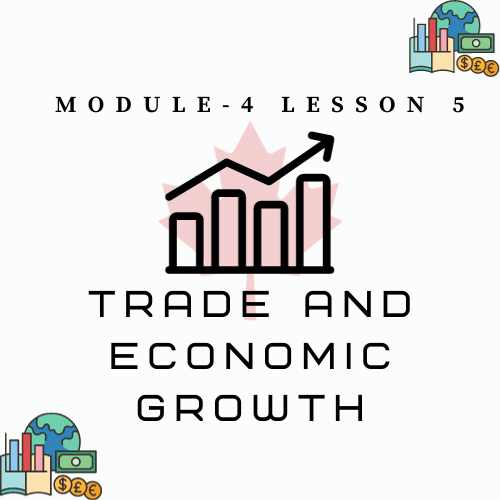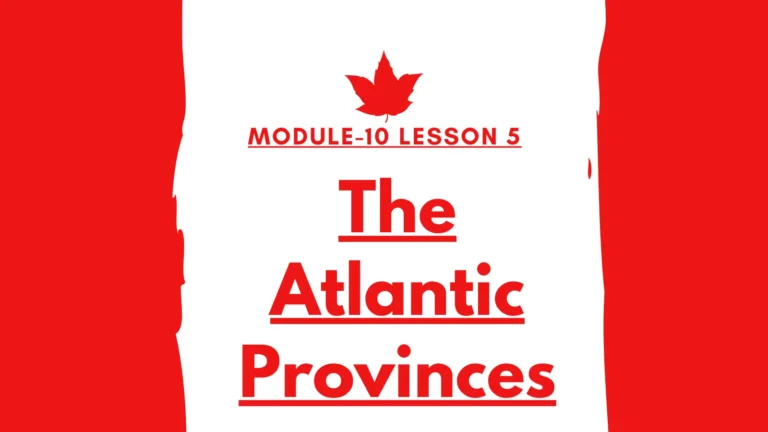Module-4 Lesson 5 Trade and Economic Growth
Trade and Economical growth has become a key element in the interplay between global economies. This is a necessity for countries that want to achieve sustained growth. Canada has used its position as a large and resource-rich country to gain a leading role in the international trading arena. The multifaceted relationship that exists between Canadian trade and its economic growth is explored in this exploration. It examines the historical context, the trade partnerships and challenges as well as the changing strategies.
Historical Foundations: From Fur Trade to Global Player
From its earliest days, trade has played a major role in Canada’s development. The fur trade was a key catalyst of the country’s economy. Canada became an important node for global trade as it evolved. In the 19th century, the Canadian Pacific Railway was completed. It connected the Atlantic and Pacific Coasts. Canada became a vital link between East and Western.
North American Free Trade Agreement (NAFTA): A Game-Changer
Signing the North American Free Trade Agreement in 1988 was a pivotal moment for Canada’s trading landscape. NAFTA removed many trade barriers by fostering stronger economic relations with Mexico and the United States. This encouraged cross-border investment and integration of North American economy. The agreement increased Canada’s exports and contributed to the economic growth of North America by creating an interconnected market.
Modern Trade Landscape: The Comprehensive Economic and Trade Agreement (CETA) and Beyond
Canada’s trade has been diversifying in recent years. CETA, the Comprehensive Economic and Trade Agreement between Canada and Europe represents an important step towards this goal. CETA opened new markets and reduced tariffs while streamlining regulatory processes. This has led to greater collaboration in the economy between Canada and EU. The ongoing discussions with the countries of the Asia-Pacific, including the Comprehensive and Progressive Agreement for Trans-Pacific Partnership, demonstrate Canada’s desire to expand its global footprint.
Trade Partnerships: United States as a Key Player
Canada’s most important trading partner is the United States. U.S. and Canada’s trade relationship is unmatched due to their geographic proximity, historic ties, economic synergies, and historical ties. In 2020, the United States, Mexico, and Canada Agreement (USMCA), which replaces NAFTA will be implemented, strengthening the partnership by addressing current trade issues, while also ensuring that a modern framework is in place for collaboration.
Asia-Pacific Engagement: Tapping into Growing Markets
Canada, recognizing the economic strength of Asia-Pacific, has pursued active trade agreements with countries like Japan, South Korea and members of CPTPP. Canada wants to be a trading partner of choice in the Asia-Pacific region, capitalizing on its expanding consumer market and middle class.
Natural Resources and Trade: The Resource-Driven Economy
The abundance of Canada’s natural resources – including minerals, oil and forestry products – has been a major factor in its changing trade dynamics. Exports of natural resources are a major contributor to Canada’s economic and trade growth. This reliance on exports of resources exposes Canada’s economy to fluctuation in global commodity demand and prices. Diversification strategies are needed to maintain long-term stability.
Challenges in Trade: Navigating Tariffs, Protectionism, and Global Uncertainties
Canada is facing challenges to navigate an economic environment that has become increasingly complex, despite the many benefits of global trade. Trade disputes and tariffs implemented by different countries may disrupt existing trade patterns, creating uncertainty for Canadian business. Global events like the COVID-19 Pandemic highlight the need for Canada to be resilient and flexible in its trade strategy.
Innovation and Technology: A Catalyst for Economic Growth
The role that technology and innovation play in the 21st Century cannot be understated. Canada is a global competitor because of its expertise in artificial intelligence, digital industries, and clean technologies. Technology for supply chain optimization and trade facilitation allows Canadian companies to access international markets with greater efficiency, driving growth in the economy and encouraging a culture innovation.
Small and Medium Enterprises (SMEs): Unlocking Trade Opportunities
The importance of supporting Canada’s small and medium businesses (SMEs) has gained momentum. Initiatives aimed at improving their access to international markets could have an economic cascade effect. Financial support programs, trade education, and market intelligence empower SMEs in exploring and maximizing international trade opportunities.

Environmental and Social Considerations: The Rise of Sustainable Trade
Sustainable trade is gaining in importance as global awareness about environmental and social concerns grows. Canada’s commitment to corporate social responsibility and environmental stewardship is influencing its trade strategy. Canada is gaining a reputation for being a global trade partner that adheres to responsible practices.
Conclusion: Shaping a Resilient and Inclusive Economic Future
Conclusion: The nexus between trade and economic development in Canada is dynamic and ever-changing. Canada’s resilience and adaptability have helped it navigate the complexity of global trade, from historical trade routes and modern partnerships to agreements and partnership. The nation is poised to create a sustainable and resilient economic future as it continues to expand its trade relations, leverage technological innovation and prioritise sustainability. As Canada navigates the constantly changing world of international trade, it will need to embrace opportunities and foster collaboration while navigating challenges.





